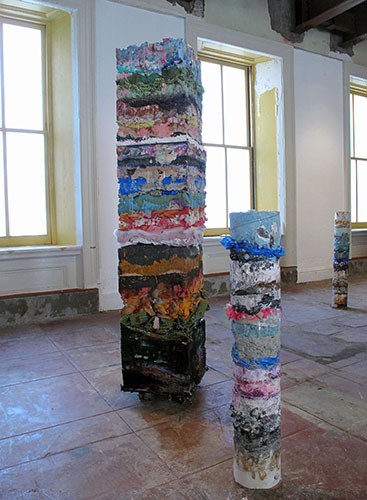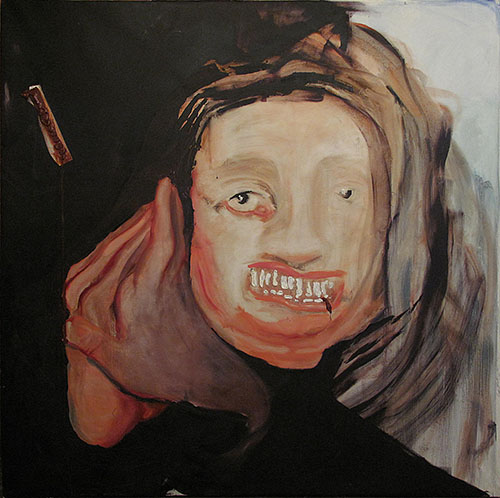 |
Against the backdrop of two art fairs, various galas and several competing MFA shows running over the same mid-May weekend, SFAI’s annual exhibition of its own MFA grads appeared in a location almost as storied as the Art Institute itself: The Old Mint – the one-time Fort Knox of the West Coast, best known for being one the few buildings to survive the 1906 earthquake. It may not be the Arsenale or the Giardini, but the students treated it as if it were. They exploited to maximum effect its dungeon-like rooms, large vaults, stairwells, high-ceilinged ballrooms and intimate anterooms.
.jpg) |
The biggest buzz — literally — came from Tom Loughlin’s installation in the basement, Foghorn. It consisted of a strategically placed subwoofer whose low-frequency emissions vibrated the granite walls, and whose tonality replicated a distant foghorn. The only visible elements were a wool mat on an elevated platform. Laying in that softly lit, dank space, absorbing the sounds, put me in meditative state — but it also put me in the mind of
what prisoners at Alcatraz must have felt waiting out their sentences. For site-specific relevance nothing else in the show compared. Dimitra Skandali’s installation of huge seaweed ball nearby gave off a musky scent, intensifying the maritime feel; but the bigger payoff from her part of the installation came from visual stimuli: woven strands which made the catacomb-like space appear even spookier than it actually is. (It received the Anne Bremer Memorial Prize, SFAI's best-in-show award.)
Videos in hallways and stairwells shattered the calm. Their booming, overlapping soundtracks made the audio portions difficult to discern. Nevertheless, it was impossible not to recognize the talent of artists like Chris Corrente, Heejin Jang and Lynn Colingham (whose upstairs video kiosk wisely employed headphones.) Jang’s stairwell piece, Duet +Nuclear = Triangle, set to a shrill, ringing electronic soundtrack, juxtaposed pixelated images of Korean dance (traditional and modern) against scenes of a fiery holocaust, bringing to mind the story of Nero fiddling while Rome burned.
 |
Hyperbole, Corrente’s rap video about gaming the system to get laid, paid, high and famous, featured a montage of erotic background images whose lightening-fast sequencing brought to mind Bruce Conner’s 1961-5 masterpiece, Cosmic Ray, a forerunner of modern music video. Colingham’s performance, Skin Horse IV – Drag, is a short, hard-hitting soliloquy voiced by the artist. She plays a man, a self-obsessed misogynist, and if, after watching her, you felt like you’ve been violated, well, that was the point of this Kara Walker-meets-Andrea Dworkin assault on hip-hop braggadocio.
.jpg) |
Amber Crabbe took aim at bureaucratic blame shifting. She covered a wall with a grid of screen shots from San Francisco Government Television and superimposed quotes overtop a single repeated visage of herself addressing a government agency where she once worked. She called it an honest conversation, which it clearly wasn’t, because the quotes formed a catalog of fake contrition of the sort we’ve come to expect from elected officials and their minions; it compared favorably to Andrea Fraser’s famous parodies of institutional doublespeak.
.jpg) |
 |
There was plenty of art about the environment. Marie-Luise Klotz’s images, from a documentary series on honeybees, ranged from magnified close-ups to frenzied abstractions, and her careful modulation between those two views riveted attention on how declining bee populations threaten the human food supply. Marcela Davis’ large-scale images of tornados and volcanoes appeared to be straight photos until you stood close, at which point you saw that her source materials were photos of the human body, stitched together to create compelling representational images. Their appearance during the week disaster struck Oklahoma seemed prescient. Raeyln Ruppel’s photos, of pastel-colored buildings under overcast skies, recall of a lot of photography coming out of China these days about heedless development. The surprise is that these were made at Mission Bay, home to SF’s only houseboat colony and new high-rises, including a UCSF complex. The area feels like a civilized no-man’s land, and Ruppel’s photos, from the series On the Edge of Utopia, portray it as such, in toxic shades that communicate the area’s still-palpable industrial past. In a sculpture installation consisting of three columns of compressed plastic refuse that seemed both solid and liquid, Hanna Kunysz imagines what core samples of the Earth’s crust might reveal in a post-apocalyptic future. Foretelling a petrochemical-fueled meltdown, these beautiful/repulsive objects ranked among the show’s highlights.
 |
So, too, did Ray Mack’s oil paintings. She appears to have studied Goya and Bacon, and her depictions of pain and suffering reflect those influences in work that can only be described as waking nightmares – masterfully rendered. In her remake of Giotto’s The Lamentation, for example, the dramatis personae appear wild-eyed, as does the subject of Lovers whose crooked teeth ooze blood. Mack’s inspirations are historic, but her thick/thin expressionist paint handling places her pictures squarely in the present. The same holds for Ingrid Wells’ painterly watercolors about child beauty queens. They plumb the low end of American pop culture. Plump-cheeked and daubed in shades of lipstick red, these pre-teens seem as vulnerable to deflation as the ratings of reality TV shows, a source for this series.